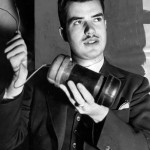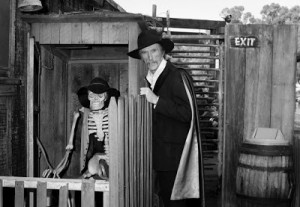Back in 2000 Alan Moore, one of the most celebrated comic authors of all time, was writing an anthology book for DC comics called Tomorrow Tales. Tomorrow Tales was homage to the old pulp comics. One of the characters in the book was Cobweb, a femme fatal who fought crime in as sexy a way as possible. One of Moore’s stories for Cobweb was blocked by DC due to subject matter, adding to Moore’s dissatisfaction with DC and ultimate departure from mainstream publishers all together.The subject matter of the story is what fascinated me when I learned of it. It was based on real events and had Cobweb meeting L. Ron Hubbard and Jack Parsons. Now I of course had heard of Hubbard before, but Parsons was new to me. It turns out that his was a fascinating story, and I can see why Moore wanted to tell it.
John Whiteside “Jack” Parsons, was born Marvel Whiteside Parsons in 1914, and I think we can guess why he may have wanted to change his name when he got the chance.
There are two very compelling and yet very different aspects to Jack Parsons life that make him worth learning about. To our sensibilities they would even seem at odds, though the fact that they weren’t to him adds to his mystique.
Parsons was born rich, but was abandoned by his father as a teenager. He attended college but did not get a degree. However I suspect that he gave up on college because it bored him. You see Parsons was a scientific genius. Despite having no degree he still managed to join the Guggenheim Aeronautical Laboratory of the California Institute of Technology. The man was literally a self-made rocket scientist. He conducted some of the earliest rocket research in the U.S. and pioneered solid fuel which led directly to the invention of JATO. In 1936 he was one of the co-founders of the Jet Propulsion Laboratory, and his research is credited with making modern rocketry possible. There are many who feel that Parsons should be credited as the father of modern rocketry.
But that was and still is unlikely due to the other interesting side of Parsons. Not only was he one of the leading scientists of his time, he was also one of America’s leading occultists.
Parsons had become involved in the Ordo Templi Orienties or OTO and thus a follower of Thelema, the religion founded by Aleister Crowley. Parsons eventually rose to lead the major American Branch of the O.T.O. known as the Agape Lodge. Parsons saw no difference between his work as a scientist and his practices as a ceremonial magician. In fact he was known to invoke the god Pan prior to rocket tests.
Parsons was also interested in science fiction, so would seek out writers as well as other artist. He ran a boarding house nicknamed “The Parsonage” that had artists, writers, and scientists as lodgers.
One of these writers was L. Ron Hubbard.
And here is where things get very interesting.
But first just a little more background.
Parsons had been married to Helen Northrup. Helen’s half-sister Sarah Northrup came to live with them which led to her having an affair with Parsons. This did not go over well with Helen and she eventually left Parsons. While they never married Parsons and Sara continued their relationship.
Now back to Hubbard.
Hubbard and Parsons got on well and began practicing magic together. They agreed to attempt a major magical ritual, known as the Babalon Working. Now while I am familiar with some practices of the OTO I certainly do not know any of the specifics of this working and I honestly do not trust accounts I have found as I suspect there is a lot of sensationalism in them. What I do know is that the purpose of the Babalon Working was to produce a Moonchild, a being that will usher in a new age for mankind. Part of the working was intended to find a third member of the working, known as the Scarlet Woman. They eventually found Marjorie Cameron, who did join them in the ritual. Not much is known of what happened of course, but Parsons declared it a success.
This event is what Alan Moore was interested in depicting. Knowing Moore he either wanted to cast Cobweb as the Scarlet Woman, or I suspect more likely claim she was the Moonchild. Either way it was the fact that the story involved Hubbard that made DC get cold feet and pull the story.
After the Babalon Working Parson, Hubbard, and Sarah Northrup formed a business partnership to run a boat company, with Parsons putting up the majority of the money to get it started. This of course is where things went south. Earlier Aleister Crowley had warned Parsons that he considered Hubbard a con man and that he would find a way to make off with Parsons’ money and Sarah. This is basically what happened. Hubbard and Sarah went off to buy the first boat, but instead of bringing it back, made off with it and the rest of the company’s funds.
Parsons, borrowing a page from the Tempest, claims to have summoned a storm that forced them back to port. Then he went the more mundane route of suing to get his money back. He recovered much of the money, but Hubbard got to keep the boat.
Hubbard ended up marrying Northrup and Parsons married Cameron.
Parsons did manage to bounce back from all this. He continued working as both a scientist and magician. He also wrote several essays on magical practices and philosophy. His writings were collected in a book called Freedom is a Two-Edged sword.
In 1952 Parsons died in an explosion in his home laboratory. There are people who will claim it was a suicide, or a magical ritual gone wrong, but honestly it was in all likelihood exactly what it looked like, an accident during a scientific experiment.
Parsons would continue to be an influence well beyond his death. Werner Von Braun was quoted as saying the Parsons was the true father of American rocketry.
The same can be said of his work as an occultist. His writings and philosophies still influence practitioners today
Writers have found him endlessly fascinating. Moore actually did use him in an issue of Promethea. Other authors would also use him because of his mixing of science and magic.
I think if Parsons Life shows anything it is that it is possible to have these very diverse sides and still make it all work. And if that doesn’t speak to us geeks, I don’t know what will.





















